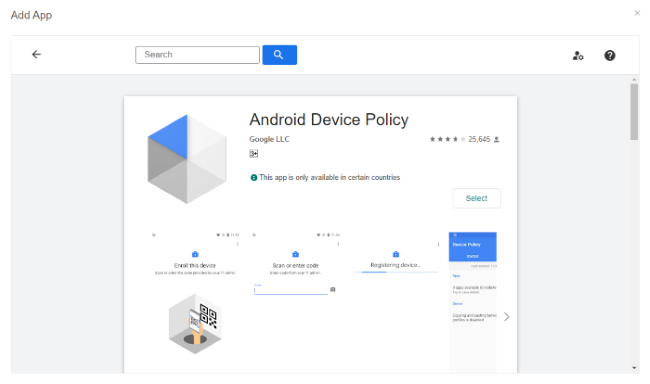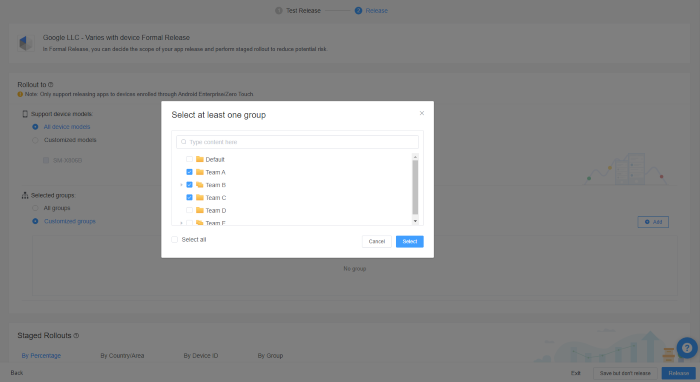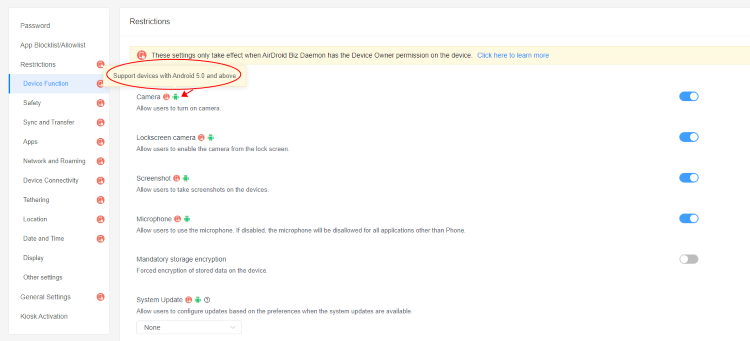How to Deploy Device Policy App to Android Devices Remotely?
Are you looking to learn more about how to deploy the Android Device Policy app remotely? Read through our short guide to learn how.
With the popularity of work-from-home and hybrid work arrangements, more employees are working remotely than ever. Employees are commonly provided with a company-issued mobile device, such as a smartphone or tablet, as part of this arrangement.
While these devices provide employers and employees with convenience, they also present many risks. These risks include using the devices for non-work purposes, moonlighting, and suspicious sites that may compromise their devices and other parts of the organization’s network.
In this environment, enterprises must secure their mobile devices as rigorously as they would desktops in an on-site office. Android Device Policy allows organizations to achieve this goal for any device powered by Android 6.0 Marshmallow or later version. This compatibility extends to smartphones and tablets with this mobile operating system, as well as kiosks, smart TVs, and other devices.
What is Android Device Policy?
With Android Device Policy, IT professionals can configure and manage company-issued devices with any EMM/MDM software that integrates with the Android Management API. One popular example is AirDroid Business, which is used by enterprises across a various industries, including everything from healthcare and logistics to retail and education.
With Android Device Policy and their chosen EMM/MDM solution, IT professionals can implement significant controls and safeguards. For security, they can set the length and strength requirements for passwords, set the time needed to elapse for the device to lock, and even remotely wipe devices. They can also set acceptable Wi-Fi networks and block access to certain apps from the Play Store based on different attributes - a company may want to allow the LinkedIn app in a country where they do client-facing sales, but not in their other markets.
1How to Deploy Android Device Policy App?
A significant advantage of Android Device Policy is that it can be deployed remotely. This feature makes it particularly suitable for enterprises on remote and hybrid work setups. These companies can have a completely remote onboarding. They ship the smartphone or tablet to their new hire and then deploy Android Device Policy to the device.
Given that the benefits of remote deployment are significant, one might assume that doing so is complex and challenging. It is easy, as is evident from the following steps.
Method 1. Deploy Android Device Policy App Using AirDroid Business
1Go to the Organization’s Managed Google Play Store
The IT professional should log into their AirDroid Business account and proceed to the Apps tab on the main navigation bar. The user should then select "Managed Google Play Store" - "+ Add App"

2Add Android Device Policy
- A pop-up menu will open that displays featured apps that can be added to devices. Please manually search for "Android Device Policy" with the search bar.
- The app listing for Android Device Policy will appear. You should click on the listing and choose Select.

3Choose Devices for App Deployment
After selecting Android Device Policy, users will be brought to a screen where they can choose which devices to rollout the application to.
You must click Add in the panel’s upper right corner, find the target devices/device group in the pop-up menu, and confirm by pressing Select.
4Formal Release
- IT professionals can deploy Android Device Policy to only specific device models or groups in Formal Release by choosing the particular segments.
- You can also stage a rollout based on different attributes, such as percentage of devices, country or area, device ID, or group.
- You must click Release in the bottom right corner to finalize a release.
- To double-check that Android Device Policy has been successfully released, the user can navigate to the Managed Google Play Store panel. Android Device Policy was successfully deploy to your device groups. You can enforce security policies for your managed devices by using this app.

2What Problems An Android Device Policy App Can Prevent?
Deploying Android Device Policy through an EMM/MDM is not only a matter of convenience: Doing so can protect businesses from serious issues that arise from remote and hybrid work arrangements.
Shirking work
Enterprises provide company-issued devices so employees can perform functions related to their roles. Unfortunately, some employees will shirk from their duties in a remote environment where colleagues do not surround them. This behavior would be easily detected through the EMM/MDM solution. Perhaps a newly hired sales person is not using the required prospecting apps, or a social media marketer does not have any activity on the Facebook, Instagram, and Twitter apps.
Non-work abuse
With their EMM/MDM, IT professionals can preemptively block apps clearly for non-work purposes such as Netflix or Spotify. However, they may be unable to anticipate all the apps that need to be blocked. IT professionals can monitor apps with high data usage as a starting point for what apps may need to be added to the blocklist. For example, perhaps a newly launched game is seeing widespread use across a department. If this is not part of any official team-building activity, the IT department may wish to restrict access so employees can focus on work.
Over-employment
Over-employment is becoming increasingly common: Employees will try to simultaneously hold two or more full-time jobs to boost their income dramatically. With an EMM/MDM, employers have a greater chance of catching these moonlighting employees. For example, perhaps the company’s official collaboration platform is Slack, but one employee also inexplicably downloaded and regularly used Microsoft Teams.
Security threats
When it comes to interacting online, people make bad decisions all the time. They set simple passwords that they never change, leave their device open in public places, and log onto suspicious WiFi networks. When it comes to their personal phone, these choices will only affect their security, but the organization’s entire network is at risk when it comes to a company-issued device. An EMM/MDM can mitigate these risks through robust cybersecurity policies that all employees must follow.
Lost or stolen devices
Employees working on-the-go may leave their devices unattended on a table in a coffee shop, in the lobby of another office, or a common area in a coworking space. Whenever a person brings their device outside, there is a risk that it may get lost or stolen. The added danger is that the person who reclaims or steals the device will have nefarious intentions, such as trying to steal company data. An EMM/MDM can prevent malicious action by allowing IT professionals to wipe lost or stolen devices remotely.
3What Are the Benefits of Deploying An Android Device Policy App?
Businesses that deploy an EMM/MDM that integrates with Android Device Policy gain several competitive advantages over their competitors.
Operational efficiency
Although individually configuring devices is time-consuming, it is still a common practice. IT professionals will set up a device, provide it to a newly hired employee, and help them start their workstation. This practice wastes valuable IT man-hours that could be better spent on higher-value technology activities.
An EMM/MDM spares businesses of this inconvenience. They can do bulk configurations of devices and still adjust individual permissions as needed. This ability gives companies operational efficiency, especially when they need it the most, such as when they open a new office or welcome a new cohort of hires.
Agile device management
Many companies are at a crossroads. While they may have a remote or hybrid work arrangement, this proposition ends anytime a device needs to be updated or has an issue. Then, the employee will have to bring the device on-site, so that the IT professional can execute the task. This practice also wastes time and undermines the reputation of companies that pride themselves in flexible, results-based work.
An EMM/MDM enables businesses to stay true to how they typically work. Rather than force an employee to bring a device to the office, IT professionals can remotely manage it as needed. These abilities include remote deployment, troubleshooting, and even wiping if it is lost or stolen. IT professionals can manage devices as well as they would in person at a shared office, which is the true meaning of flexibility: Businesses can achieve what they did before with even more convenience.
Top-notch cybersecurity
Businesses in every industry routinely suffer from data breaches, hacks, and other attacks. While the attack vectors are diverse - including everything from malicious pop-ups to emails - the organization’s employees are the most common culprits. They are partly to blame because few take cybersecurity seriously.
With an EMM/MDM, businesses can set up robust cybersecurity practices for their mobile devices, a common endpoint vulnerable to attacks. These measures protect the organization’s data, trade secrets, and other confidential information. While no company is ever completely free from the risk of cybersecurity incidents, using an EMM/MDM will go a long way toward mitigating risks.
4Use AirDroid Business to Configure Policy As Your Android Device Policy Manager
AirDroid Business makes it easy for enterprises to configure Policy for Android device group. Upon signing up and finish device enrollment, IT professionals can then use this tool to configure Policy for their company-issued devices.

Outside of any restrictions, IT professionals will have broad control in setting the Android Device Policy for their company, including:
- Password configuration - To prevent unauthorized access, the company can set the password rules to ensure compliance. If someone tries to breach a device, the company can also reset the password remotely from AirDroid Business admin console.
- App blocklist or whitelist - Organizations can take one of two approaches when managing apps. A blocklist extends access to all apps in the Play Store except those that are prohibited by admin, while a whitelist is more restrictive because it allows access to only named apps. Companies considering a whitelist may even want to consider Android Kiosk mode, which locks devices to only one or several apps. This setting may be helpful for devices with limited use cases, like a delivery driver who should only be using a navigation app. This flexibility allows organizations to choose the best option for their particular needs.
- Device restrictions - IT professionals can also restrict the device in numerous other ways, including the ability to restore factory settings or reboot in safety mode, transfer files with hardware devices like USBs, install or uninstall an app, or even access the camera. With these restrictions, businesses can ensure their device is protected and used only in the way they are intended.
- Operating environment - Rather than enabling the device to work in any environment, IT professionals can configure a dedicated operating environment based on WiFI, access point name (APN), or other settings. This dedicated operating environment prevents employees from putting their device at risk, such as by using an unsecured internet connection at a public cafe.
Device management is further enhanced by the ability to execute updates of the OS and even define compliance behaviors, so users are forced to adhere to the organization’s policies.
AirDroid Business is the ideal solution for businesses that want an efficient, easy, and comprehensive solution for deploying and managing their Android Device Policy.
Choosing your Android Device Policy Manager
Most companies managing a large device ecosystem understand that they need a capable EMM/MDM that works with Android Device Policy. Most hesitate on this decision because they are unsure what features to look for. Because a management solution is the backbone of an organization’s device ecosystem, businesses should choose a solution that operates as they do: It should be cost-effective, innovative, and efficient.
From this perspective, AirDroid Business presents a compelling choice. It offers flexible pricing and plans, including a free trial so businesses can gain value immediately. It also has an easy-to-use interface so businesses can maximize the features, settings, and controls offered by Android Device Policy. Finally, it provides the ability for remote OS updates and compliance requirements, ensuring that these devices are managed as efficiently as they would be on-site. With AirDroid, businesses don’t only get policy - they get execution.






Leave a Reply.